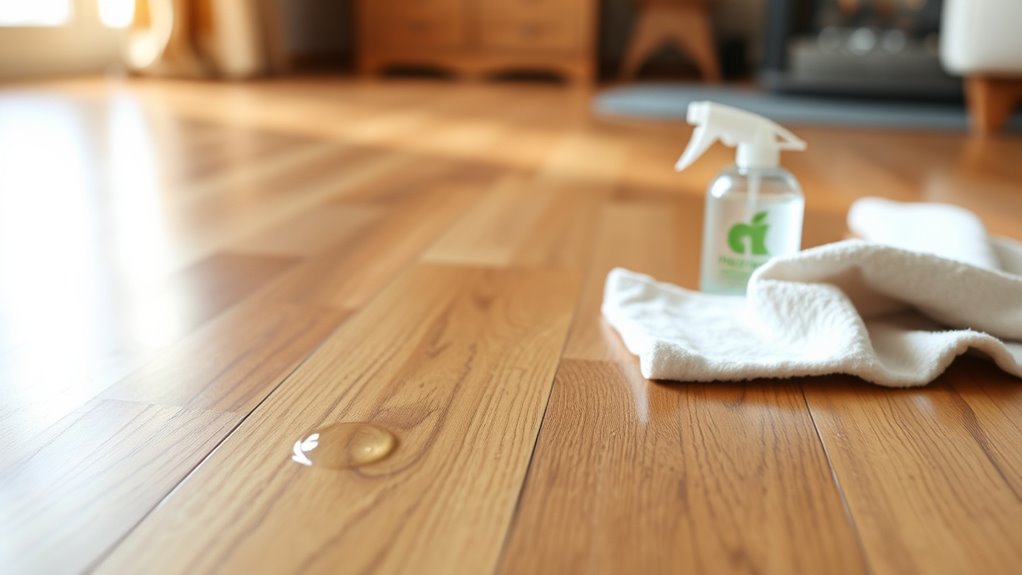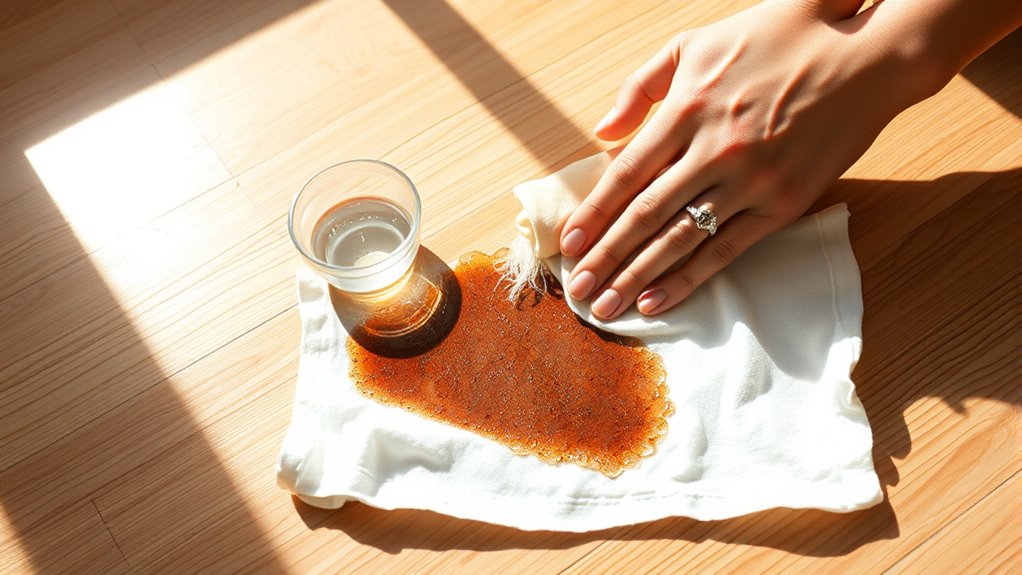To get pee stains out of your hardwood floors, first identify your floor’s finish and blot up excess urine quickly with a clean cloth. Mix a gentle soap and water solution, then test it on a hidden spot before gently cleaning the stain. Use diluted white vinegar or baking soda to neutralize odors, and wipe the area dry thoroughly. If stains linger, sanding and refinishing may be needed. Keep following these steps to fully restore your floor’s appearance.
Identify the Type of Hardwood Finish

Before you begin cleaning, it’s important to identify the type of finish on your hardwood sol. Hardwood finishes vary, and knowing the finish type helps you choose the right cleaning approach without damaging your floor. Common hardwood finishes include polyurethane, oil-based, water-based, wax, and aluminum oxide. Polyurethane finishes form a tough, protective layer that’s water-resistant, while oil-based finishes soak into the wood, offering a natural look but less protection. Wax finishes create a soft sheen but require gentle care. Aluminum oxide is highly durable, often factory-applied. To identify your finish type, examine your floor’s sheen and texture or consult product information if available. By understanding your hardwood finishes and finish types, you’ll maintain your floor’s integrity and enjoy the freedom to clean effectively without fear of damage.
Blot Up Excess Urine Immediately
When you notice urine on your hardwood floor, act quickly to blot up as much as possible. Use a clean, absorbent cloth or paper towels and gently press down—avoid rubbing, which can spread the stain and push urine deeper into the wood. Effective blotting techniques focus on lifting moisture rather than smearing it. Change to a fresh cloth as it becomes saturated to maximize absorption. Promptly removing excess urine is essential for successful stain removal and preventing long-term damage like discoloration or odor. By acting fast and using the right blotting methods, you maintain your floor’s integrity and make subsequent cleaning easier. Remember, the key to controlling pee stains on hardwood floors lies in immediate, careful blotting before the urine sets in.
Prepare a Gentle Cleaning Solution

To clean pee stains without damaging your hardwood floors, you’ll need to choose safe ingredients like mild dish soap and water. Make sure to mix them in proper ratios—usually a few drops of soap per cup of water—to avoid excess moisture. This gentle solution will effectively lift stains while protecting your floor’s finish.
Choosing Safe Ingredients
Although hardwood floors are durable, harsh chemicals can damage their finish, so you’ll want to choose safe, gentle ingredients for your cleaning solution. Opt for safe cleaning alternatives that protect your floor and avoid harmful residues. Natural stain removers like vinegar, baking soda, and mild soap are effective and eco-friendly choices. Using these keeps your space fresh while giving you freedom from toxic chemicals.
| Ingredient | Avantage | Emotion Evoked |
|---|---|---|
| vinaigre blanc | Natural disinfectant | Trust |
| Bicarbonate de soude | Odor neutralizer | Relief |
| Mild Dish Soap | Nettoyant doux | Confort |
| Eau | Safe solvent | Simplicity |
| Huiles essentielles | Pleasant scent | Calm |
Choosing these ingredients lets you clean confidently without compromising your floor’s integrity.
Mixing Proper Ratios
Selecting safe ingredients sets the foundation, but mixing them in the right proportions guarantees your cleaning solution is both effective and gentle. When preparing your solution, stick to recommended mixing ratios—usually a cup of white vinegar to a gallon of warm water works well for hardwood floors. Avoid using too much vinegar, as excessive acidity can damage the finish. If you prefer a milder approach, dilute a few drops of gentle dish soap in water, ensuring the soap concentration remains low. Always mix cleaning solutions thoroughly to distribute ingredients evenly. By following precise mixing ratios, you maintain the solution’s strength without risking harm to your floors, giving you the freedom to clean confidently and keep your hardwood looking pristine without harsh chemicals or damage.
Test the Cleaner on a Small Area
Before applying any cleaner to your hardwood floor, you should test it on a small, inconspicuous area first. This step guarantees the cleaning products won’t damage or discolor your wood, helping maintain your floor’s integrity and appearance. Choose a spot that’s hidden, like under a piece of furniture or near a corner. Apply a small amount of the cleaner, wait a few minutes, then check for any adverse reactions such as fading, warping, or residue. Testing prevents unexpected damage and supports effective stain prevention by confirming the cleaner’s compatibility. Taking this precaution lets you confidently proceed with cleaning, preserving the natural beauty and freedom your hardwood floors provide. Never skip this vital step when dealing with any stain removal solution.
Gently Clean the Stained Area

Start by selecting a mild cleaning solution to protect your hardwood finish. Use soft cloths or sponges to gently lift the stain without scratching the surface. Keep water use minimal to prevent damage from moisture soaking into the wood.
Choose Mild Cleaning Solutions
When tackling pee stains on hardwood floors, you’ll want to use a mild cleaning solution that won’t damage the wood’s finish. Opt for mild detergents diluted with water to gently break down the stain without harsh chemicals. Avoid anything abrasive or overly acidic, as these can strip the protective layer of your floor. If you prefer natural alternatives, a mixture of white vinegar and water works well to neutralize odors and lift stains while being safe for most finishes. Another option is a mild castile soap solution, which cleans effectively without leaving residue. Always test your chosen solution on a small, inconspicuous area first to verify it doesn’t alter the floor’s appearance. This careful approach helps maintain the wood’s integrity while freeing your space from unwanted marks.
Use Soft Cleaning Tools
Although using the right cleaning solution is essential, you’ll also need soft tools to gently lift the stain without scratching the hardwood. Start with soft brushes designed to reach into the grain of the wood, loosening the pee residue carefully. Avoid stiff bristles that can damage the surface. After brushing, use microfiber cloths to blot and wipe the area. These cloths are gentle yet effective at absorbing moisture and lifting stains without spreading them further. Work in small sections, applying light pressure to avoid abrasion. Using soft brushes and microfiber cloths guarantees you clean thoroughly while preserving your floor’s finish. This method gives you control, helping you maintain your hardwood’s natural beauty and freedom from harsh damage.
Avoid Excessive Water Use
One key step to preserving your hardwood floors while cleaning pee stains is to avoid using excessive water. Over-wetting can damage the wood, warp the boards, and encourage mold growth. Practicing good water conservation not only protects your floors but also aligns with responsible cleaning techniques. When you clean the stained area, use just enough moisture to lift the stain without saturating the wood.
To gently clean effectively:
- Dampen a soft cloth or sponge slightly
- Blot the stain rather than scrubbing aggressively
- Use minimal liquid cleaning solution diluted with water
- Dry the area promptly with a clean, dry towel
These steps help maintain your hardwood’s integrity while efficiently removing pee stains without wasting water.
Use Baking Soda to Neutralize Odors
Since baking soda naturally absorbs and neutralizes odors, it’s an effective solution for tackling pee stains on hardwood floors. To use it, sprinkle a generous layer of baking soda over the affected area. The baking soda benefits include its ability to draw out moisture and neutralize the acidic compounds in urine, preventing lingering smells. Let it sit for several hours or overnight to maximize odor absorption. Afterward, vacuum or sweep up the baking soda thoroughly. This method not only tackles unpleasant odors but also helps keep your hardwood floor fresh without harsh chemicals. By using baking soda, you gain a simple, natural way to reclaim your space’s freedom from unwanted smells.
Apply White Vinegar for Deep Cleaning
When you want to remove stubborn pee stains and odors from hardwood floors, applying white vinegar offers a powerful, natural cleaning solution. Vinegar benefits include its ability to break down urine compounds and deodorize without harsh chemicals. To use it effectively, dilute white vinegar with water in a 1:1 ratio. Then, apply it gently to the affected area.
Keep these points in mind:
- Use vinegar regularly but avoid overdoing to protect floor finish
- Test on a small spot first to verify no discoloration
- Vinegar’s acidity neutralizes alkaline urine residues
- Combine with proper cleaning frequency for lasting results
This approach lets you reclaim your floor’s freshness and maintain its integrity naturally and efficiently.
Wipe the Floor Dry Thoroughly
After applying the vinegar solution, grab an absorbent cloth to wipe the floor dry thoroughly. Make sure no moisture remains, as lingering dampness can damage the hardwood. Taking this step carefully will help protect your floor and prevent any further staining.
Use Absorbent Cloth
Grab an absorbent cloth to thoroughly wipe the affected area, ensuring you soak up all the moisture. Using absorbent materials is key in effective cleaning techniques for hardwood floors, as they prevent liquid from seeping deeper into the wood. Choose a cloth that’s:
- Highly absorbent, like microfiber or cotton
- Clean and dry to avoid spreading residue
- Soft enough to protect the wood surface
- Large enough to cover the stain efficiently
Press the cloth firmly to draw up as much moisture as possible, avoiding harsh rubbing that could damage the floor. Repeat the process with fresh sections of the cloth until the area feels dry to the touch. This method limits lingering odors and potential discoloration, setting you up for a successful cleanup without risking damage to your hardwood floors.
Ensure Complete Dryness
Since moisture can easily seep into hardwood, you’ll want to wipe the floor dry thoroughly to prevent damage. Start by using a clean, absorbent cloth or microfiber towel to soak up any remaining dampness after cleaning the pee stain. Apply gentle pressure and work in small sections to guarantee no moisture lingers. For effective moisture control, consider using drying techniques like air circulation—open windows or use fans to speed up evaporation. Avoid leaving the area wet, as prolonged exposure can cause warping or discoloration. If necessary, repeat wiping with a dry cloth until the surface feels completely dry to the touch. Prioritizing thorough drying not only protects your floor but also keeps your space fresh and stain-free, giving you peace of mind and freedom from lingering odors or damage.
Sand and Refinish if Stains Persist
If the pee stains have deeply set into your hardwood floors and cleaning hasn’t worked, sanding and refinishing may be your best option. You’ll need to carefully remove the top layer of wood where the stain resides using proper sanding techniques. Start with coarse grit sandpaper, then progress to finer grits for a smooth finish. After sanding, consider these refinishing options:
- Apply a stain-blocking primer to prevent discoloration
- Choose a finish that matches your floor’s original look
- Use durable sealants to protect against future damage
- Allow adequate drying time between coats
This approach restores your floor’s natural beauty and removes stubborn stains. Sanding and refinishing require patience and precision, but they offer a lasting solution when simpler methods fail.
Maintain Hardwood Floors to Prevent Future Stains
Although accidents can happen, maintaining your hardwood floors regularly will help prevent pee stains from setting in. Start by implementing simple preventative measures like placing rugs or mats in high-risk areas and training pets to use designated spots. Wipe up spills immediately using a damp cloth to avoid moisture damage. Regular maintenance includes sweeping or vacuuming to remove dirt and grit that can scratch the surface. Use a hardwood floor cleaner recommended by the manufacturer to keep the finish intact and resistant to stains. Periodically check for damage or worn finishes and address them promptly. By staying consistent with these preventative measures and regular maintenance, you’ll protect your floors, maintain their natural beauty, and enjoy a cleaner, stain-free environment with less effort over time.




